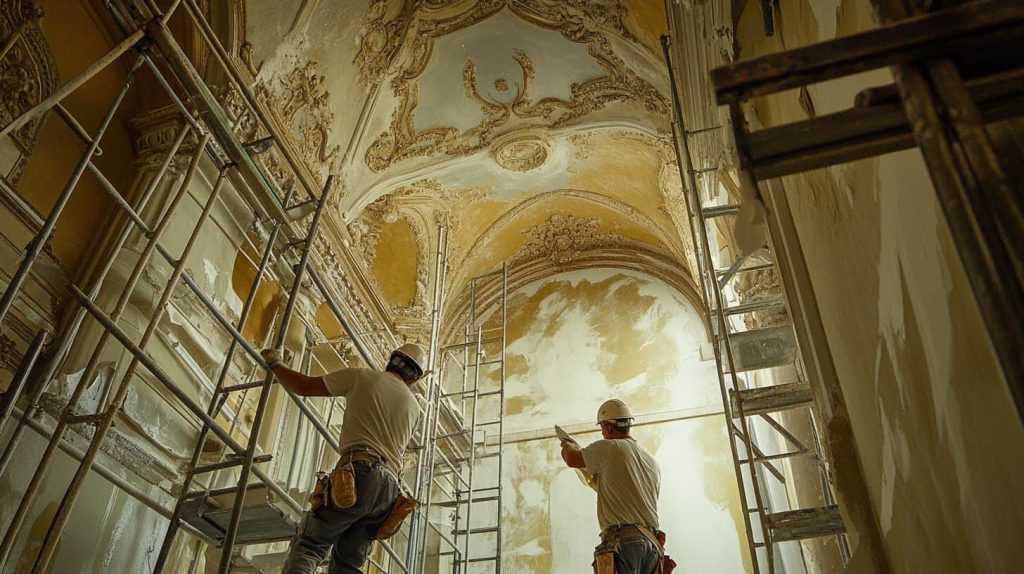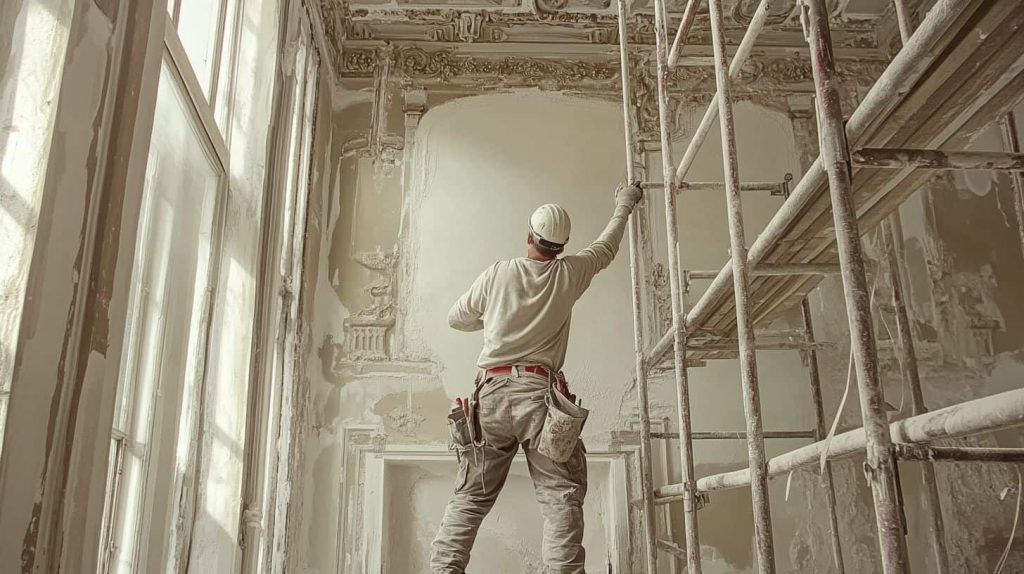Traditional Materials Meet Modern Sustainability for Authentic, Breathable Surfaces
Restoring old buildings can be difficult for property owners. Lime Plaster has been used in construction for centuries. This blog explains the benefits of using Lime Plaster in restoration projects.
Discover why Lime Plaster is the best choice.
Key Takeaways
- Lime plaster lets walls breathe, allowing moisture to escape and preventing mold growth.
- It is very strong, with Type N mortar having a strength of 750 PSI, ensuring long-lasting walls.
- Lime plaster is eco-friendly, has a low carbon footprint, and absorbs carbon dioxide as it cures.
- It comes in different types: Grade G covers 22 sq ft per 1/4-inch, Grade F covers 90 sq ft per 1/16-inch, and Grade XF for smooth finishes.
- Lime plaster works well with historic materials like brick and stone, keeping old buildings authentic and durable.
Understanding Lime Plaster

Lime plaster has been a key building material for centuries, and it is known for its strength and beauty. It is made from limestone and water and comes in various types to suit different restoration projects.
Historical Significance in Building
Lime plaster has been used for centuries to restore historic structures. It lets moisture and salts escape, protecting old walls from damage. This durable building material works well with raw brick, stone, and non-rusting lath.
Heritage buildings rely on lime plaster to maintain their timeless elegance and durability. Its compatibility with traditional materials ensures restorations preserve the building’s original character.
Composition and Types
Hydraulic lime plaster is crafted from limestone that is heated and then mixed with water and sand. It is available in three grades: coarse-sanded Grade G, fine-sanded Grade F, and extra fine-sanded Grade XF.
Each grade serves different restoration needs, ensuring durability and strength. Non-hydraulic lime, also known as lime putty, sets by absorbing carbon dioxide from the air. This type remains flexible, allowing walls to breathe and adapt to movement without cracking.
Different types of lime plaster offer various benefits for restoration projects. Coarse-sanded lime is ideal for rough surfaces, providing a sturdy base. Fine-sanded lime creates smooth finishes suitable for intricate details.
Extra fine-sanded lime is perfect for delicate work on historic buildings. Custom colors are available to match original aesthetics, enhancing the preservation of historic buildings.
Understanding the composition and types of lime plaster helps property owners select the best option for their specific restoration needs.
Advantages of Using Lime Plaster in Restoration

Lime plaster breathes, allowing moisture to escape and protecting buildings from damage. Its strength and eco-friendly nature make it perfect for restoring historic properties.
Breathability and Durability
Lime plaster allows moisture to escape, keeping walls dry. This permeability prevents trapped moisture, reducing mold growth. With a strength of 750 PSI for Type N mortar, lime plaster stands strong over time.
Its durability ensures walls last longer, making it ideal for restoration projects.
Breathable materials like lime plaster are essential for healthy and lasting buildings.
Environmental Benefits
Lime plaster has a low carbon footprint compared to cement-based alternatives. It produces no volatile organic compounds (VOCs), ensuring cleaner indoor air.
Furthermore, lime plaster absorbs carbon dioxide as it cures, reducing greenhouse gases. This sustainable building material supports eco-friendly restoration projects.
Compatibility with Historical Materials
Lime plaster blends seamlessly with historical materials, making it ideal for historic restoration. It works well with brick, stone, and older building techniques. This natural material allows salt to escape, preventing damage and preserving the structure.
Using lime plaster maintains the authenticity of heritage buildings and supports their longevity.
Many property owners choose lime plaster for its compatibility with historic preservation. It adapts to different building projects without causing harm. Lime plaster’s flexibility matches the movement of older structures, reducing the risk of cracks.
By selecting lime plaster, restorers ensure durable and sustainable outcomes for various historic buildings.
Unique Properties of Lime Plaster

Lime plaster has special features that make it ideal for restoration. These qualities ensure buildings last longer and stay healthy.
Natural Mold and Mildew Resistance
Lime plaster naturally resists mold, mildew, and algae. This resistance promotes a healthier home environment. Made from 100% hydraulic lime, it is eco-friendly and non-toxic. Its breathability allows moisture to escape, lowering the chance of mold growth.
Lime plaster is immune to salts and sulfates, preventing decay that fosters mold issues. Without harmful VOCs, indoor air quality stays high, reducing health risks.
Carbon Dioxide Absorption
Lime plaster absorbs carbon dioxide from the air as it hardens. This natural process helps reduce carbon emissions, making it an eco-friendly choice for restoration projects. Using lime mortar supports environmental sustainability by lowering the overall carbon footprint.
Lime plaster’s ability to capture CO₂ highlights the benefits of using lime in building and restoration.
Flexibility and Crack Resistance
Lime plaster bends with building movements. This flexibility helps prevent cracks from forming. Unlike cement plaster, lime plaster stays soft and can move without breaking. Property owners benefit from fewer repairs and a longer-lasting finish.
Crack resistance is a key advantage of using lime plaster. It adapts to temperature changes and settling without splitting. By avoiding Portland cement, lime plaster remains more adaptable.
This makes it ideal for older structures needing gentle, durable materials.
Modern Innovations in Lime Plaster Application

Today, hydraulic lime and eco-friendly additives make lime plaster easier to apply and more durable—learn how these modern methods can enhance your restoration project.
Hydraulic and Non-Hydraulic Lime
Hydraulic lime sets through a chemical reaction with water, making it ideal for damp areas. It comes in three grades: Coarse-sanded Grade (G), Fine-sanded Grade (F), and Xtra Fine-sanded Grade (XF).
Grade G provides maximum strength for high-traffic zones. Grade F offers balanced workability and strength, which is suitable for most restoration projects. Grade XF delivers a smooth finish for detailed work.
Non-hydraulic lime hardens by absorbing carbon dioxide from the air. It remains flexible and breathable, matching historical materials. This lime type enhances durability and prevents moisture buildup in older buildings.
Property owners choose non-hydraulic lime for its compatibility with traditional structures and long-lasting performance.
Use of Natural Additives
Natural additives enhance lime plaster’s performance significantly. Goat hair bundles, available for $20, are a popular choice. They increase the plaster’s strength and flexibility, making it more durable.
Adding goat hair helps lime plaster resist cracks and wear. Straw and lime aggregates are other effective additives. These materials improve breathability and reduce mold growth. Using natural additives ensures lime plaster blends well with historical materials.
Incorporating natural additives offers many benefits. They support the longevity of lime plaster, ensuring walls and ceilings last longer. Environmental benefits include using sustainable, natural materials.
Property owners appreciate the reduced maintenance needs. Natural additives also maintain lime plaster’s compatibility with old buildings. This makes lime plaster a great choice for restoration projects.
Moving forward, understanding lime plaster’s unique properties is essential.
Case Studies: Successful Restoration Projects Using Lime Plaster
Discover how lime plaster restored historic landmarks and supported sustainable projects.
Heritage Buildings
Heritage buildings require careful restoration to preserve their original charm. Lime plaster offers key benefits for these structures. It is compatible with historical materials, ensuring that walls remain stable and authentic.
Lime plaster allows moisture to evaporate, preventing damage inside the walls. Its durability means heritage buildings can last longer without frequent repairs. Workshops like ARTisAn Objective® Workshop MAS-05 teach essential techniques, such as plaster medallions casting, enhancing restoration quality.
Using lime plaster supports the longevity and integrity of historic properties.
Sustainable Building Restorations
Sustainable building restorations use lime plaster to enhance durability and breathability. The Tadelakt lime plaster technique utilizes the Ecologic™ Plaster System, which resists mold and absorbs carbon dioxide.
Lime plaster matches historical materials, ensuring compatibility and longevity in restoration projects.
Lime plaster offers flexibility, preventing cracks and extending building life. It reduces environmental impact by using natural materials and lower emissions than cement mortar. Property owners benefit from sustainable, long-lasting finishes that preserve their buildings effectively.
Exploring the Use of Lime Plaster in Different Restoration Projects

Explore how lime plaster is used in various restoration projects, such as brick repair, exterior finishes, EIFS fixes, and hotel renovations—read on to learn more.
Exterior Painting and Plaster Finishes
Lime plaster provides sturdy exterior finishes. A 1/4-inch coarse-sanded lime plaster covers 22 square feet. The fine 1/16-inch grade covers 90 square feet. This allows for different textures and styles.
Lime plaster’s breathability keeps walls dry and prevents damage from moisture.
Exterior painting with lime plaster ensures long durability and longevity. It resists mold growth naturally, lowering maintenance needs. Lime plaster is eco-friendly as it absorbs carbon dioxide.
Its flexibility reduces cracks, maintaining a smooth finish. Property owners benefit from using lime plaster finishes for sustainable and compatible restorations.
Brick Restoration and Tuck-Pointing
Following exterior painting and plaster finishes, brick restoration and tuck-pointing are essential steps. Using lime plaster for stone or brick parging offers many advantages of lime plaster.
It blends well with historical materials, enhancing breathability and durability. This method helps prevent mold growth and extends the life of the brickwork. Lime plaster’s flexibility resists cracks, ensuring long-lasting repairs.
Property owners appreciate the environmental benefits and compatibility of lime plaster with traditional bricks, making it a great choice for restoration projects.
EIFS Repair
EIFS repair keeps buildings strong and energy-efficient. Indiana Wall Systems offers top EIFS and stucco services in Indiana. Their expert team handles cracks and moisture issues quickly.
Using modern plaster techniques, they ensure long-lasting results.
Choosing EIFS repair helps protect your property. It resists mold growth and withstands weather changes. Sustainable building projects benefit from EIFS’s durability and breathability.
Trust Indiana Wall Systems for reliable restoration and maintenance.
Hotel Restoration
Lime plaster is excellent for hotel restoration projects. It is an eco-friendly construction material that maintains historical buildings. The breathable plaster stops water from getting trapped in walls, preserving old masonry.
It’s natural mold and mildew resistance makes restorations last longer. Custom mixes of lime plaster meet unique hotel needs. Using proper lime products and methods ensures the restoration stays strong over time.
Conclusion
Lime plaster strengthens and preserves buildings. It allows walls to breathe and lasts for years. This plaster helps the environment with its low emissions. Ecologic™ PLASTER TOPCOAT™ Platinum offers a classic look and strong finish.
Choose lime plaster to protect and enhance your property.
FAQs
What are the benefits of using lime plaster in restoration projects?
Lime plaster offers many benefits. It is flexible, allowing buildings to move without cracking. Lime plaster also makes walls breathe, preventing moisture buildup. Additionally, lime plaster is less brittle than gypsum plaster, ideal for historic buildings.
How does lime plaster compare to other types of plaster?
Lime plaster is made from slaked lime and is highly breathable. Unlike gypsum plaster, lime plaster is less likely to crack and can adapt to building movements. This makes lime plaster a great choice for both construction and restoration.
How long does lime plaster last in buildings?
Lime plaster is long-lasting when properly made and applied. It can endure many years, maintaining its appearance and strength. The durability of lime plaster makes it valuable for restoration projects.
What is lime wash and how is it used with lime plaster?
Limewash is a finish made from lime plaster. It is applied to walls to add color and protection. Limewash allows walls to stay breathable and helps maintain the integrity of the restoration.
Why is lime plaster a good choice for modern buildings?
Lime plaster works well in modern buildings because of its versatility. It can be used with traditional materials and new construction methods. Lime plaster also provides a natural look and helps regulate indoor humidity.
What is required to work with lime plaster effectively?
Working with lime plaster requires using hydrated lime and understanding the process of lime plaster application. Proper techniques ensure that lime plaster makes strong, durable walls. Human oversight is important to maintain quality in restoration projects.



